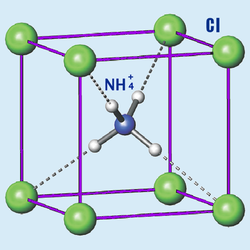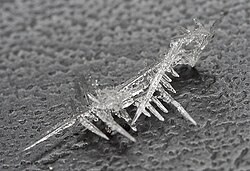Ammonium chloride
Ammonium chloride is a chemical compound composed of ammonium and chloride ions. It is a colorless crystalline compound. It is used in soldering. It is also used as an electrolyte in the Leclanche cell, a type of primary cell. Ammonium chloride can be deprotonated by strong bases such as sodium hydroxide to produce ammonia gas.It is sublime compound.
| Ammonium chloride | |
|---|---|

| |

| |
| IUPAC name | Ammonium chloride |
| Other names | Sal ammoniac, Salmiac, Nushadir salt, Sal armagnac, Salt armoniack, Salmiak |
| Identifiers | |
| CAS number | |
| PubChem | |
| EC number | 235-186-4 |
| KEGG | D01139 |
| ChEBI | CHEBI:31206 |
| RTECS number | BP4550000 |
| SMILES | [Cl-].[NH4+] |
| Properties | |
| Molecular formula | H4ClN |
| Molar mass | 53.49 g mol-1 |
| Appearance | White solid, hygroscopic |
| Odor | Odorless |
| Density | 1.519 g/cm3[2] |
| Melting point |
338 °C, 611 K, 640 °F |
| Boiling point | |
| Sublimes at 337.6 °C[4] ΔsublH | |
| Solubility in water | 244 g/L (−15 °C) 294 g/L (0 °C) 383.0 g/L (25 °C) 454.4 g/L (40 °C) 740.8 g/L (100 °C)[3] |
Solubility product (Ksp)
|
30.9 (395 g/L)[1] |
| Solubility | Soluble in liquid ammonia, hydrazine, Slightly soluble in acetone Insoluble in diethyl ether, ethyl acetate[4] |
| Solubility in methanol | 32 g/kg (17 °C) 33.5 g/kg (19 °C) 35.4 g/kg (25 °C)[4] |
| Solubility in ethanol | 6 g/L (19 °C)[5] |
| Solubility in glycerol | 97 g/kg[4] |
| Solubility in sulfur dioxide | 0.09 g/kg (0 °C) 0.031 g/kg (25 °C)[4] |
| Solubility in acetic acid | 0.67 g/kg (16.6 °C)[4] |
| Vapor pressure | 133.3 Pa (160.4 °C) 6.5 kPa (250 °C) 33.5 kPa (300 °C)[5] |
| Acidity (pKa) | 9.24 |
| -36.7·10−6 cm3/mol[6] | |
| Refractive index (nD) | 1.642 (20 °C)[4] |
| Structure | |
| Crystal structure | CsCl, cP2[7] |
| Space group | Pm3m, No. 221 |
| Lattice constant | a = 0.3876 nm |
| Thermochemistry | |
| Std enthalpy of formation ΔfH |
−314.43 kJ/mol[5] |
| Standard molar entropy S |
94.56 J/mol·K[5] |
| Specific heat capacity, C | 84.1 J/mol·K[5] |
| Pharmacology | |
| ATC code | |
| Hazards | |
| NFPA 704 |
|
| Flash point | Non-flammable |
| U.S. Permissible exposure limit (PEL) |
none[8] |
| Related compounds | |
| Other anions | Ammonium fluoride Ammonium bromide Ammonium iodide |
| Other cations | Sodium chloride Potassium chloride Hydroxylammonium chloride |
| Except where noted otherwise, data are given for materials in their standard state (at 25 °C, 100 kPa) | |
Ammonium Chloride Media
Demonstration of a synthesis of ammonium chloride. Concentrated ammonia and hydrochloric acid solutions are added to two gas-washing bottles, respectively. Using rubber pumps, air (acting as gas-carrier) is injected in the gas-washing tubes causing the streams of ammonia and hydrogen chloride in air to collide and react giving the solid product, ammonium chloride.
Related pages
References
- ↑ "Solubility Products of Selected Compounds". Salt Lake Metals. Archived from the original on 2015-10-21. Retrieved 2014-06-11.
- ↑ Haynes, William M., ed. (2011). CRC Handbook of Chemistry and Physics (92nd ed.). Boca Raton, FL: CRC Press. p. 4.46. ISBN 1439855110.
- ↑ Seidell, Atherton; Linke, William F. (1919). Solubilities of Inorganic and Organic Compounds (2nd ed.). D. Van Nostrand Company.
Results here are multiplied by water's density at temperature of solution for unit conversion. - ↑ 4.0 4.1 4.2 4.3 4.4 4.5 4.6 ammonium chloride Archived 2015-07-23 at the Wayback Machine. Chemister.ru (2007-03-19). Retrieved on 2018-01-23.
- ↑ 5.0 5.1 5.2 5.3 5.4 Pradyot, Patnaik (2003). Handbook of Inorganic Chemicals. The McGraw-Hill Companies, Inc. ISBN 978-0-07-049439-8.
- ↑ Haynes, William M., ed. (2011). CRC Handbook of Chemistry and Physics (92nd ed.). Boca Raton, FL: CRC Press. p. 4.131. ISBN 1439855110.
- ↑ Breñosa, A.G; Rodríguez, F; Moreno, M (1993). "Phase transition temperatures and thermal hysteresis in NH4Cl1−xBrx (x≤0.05) crystals determined through charge transfer spectra of Cu2+(II) centres". Solid State Communications. 85 (2): 135. Bibcode:1993SSCom..85..135B. doi:10.1016/0038-1098(93)90362-Q.
- ↑ NIOSH Pocket Guide to Chemical Hazards. "#0029". National Institute for Occupational Safety and Health (NIOSH).


